Across Europe’s digital economy, few companies have managed to turn technical innovation into a working business model as effectively as MILC (Media Industry Licensing Content). Founded by media entrepreneur Hendrik Hey, the Luxembourg-based company has evolved from a niche blockchain marketplace into one of the continent’s most trusted Web3 consulting and infrastructure firms.
What began as a solution for fragmented media licensing is now reshaping how industries manage ownership, compliance, and transparency. With new partnerships forming and large-scale projects nearing launch, MILC’s next phase signals a broader transformation that connects media, technology, and clean energy under one practical framework.
From Marketplace to Infrastructure
When Hendrik Hey first introduced MILC, his goal was to simplify how creators licensed and monetized their work. The Rights Marketplace allowed intellectual property to be tokenized, tracked, and licensed instantly across borders. It solved the long-standing problem of fragmented ownership that had slowed the global media industry for years.
However, Hey quickly saw that the underlying technology had potential far beyond entertainment. The same system that managed rights for film or television could also serve as a backbone for other industries that needed secure, transparent, and compliant data exchange. That insight pushed MILC to grow from a platform into an infrastructure company that could bring Web3 technology into the core operations of traditional businesses.
Europe’s business landscape made this evolution possible. Regulation across the continent is clear and often demanding, which creates an environment where innovation and compliance must move together. “Our mission has always been to make Web3 technology accessible and practical for European businesses,” states Hendrik Hey, MILC’s founder and CEO. “We’re not just implementing blockchain solutions; we’re helping companies reimagine their operations for the digital age while ensuring compliance with European regulations.”
The model works. By offering strategic guidance alongside technology implementation, MILC has built a rare mix of credibility and flexibility. It gives partners across industries the confidence to experiment with blockchain solutions while maintaining operational stability. According to a report, Europe’s blockchain market is expected to surpass $59 billion by 2028, and MILC’s consulting division is positioned to guide many of those projects from concept to real-world application.
Leadership Rooted in Communication and Credibility
Hey’s background explains MILC’s unusually human approach to complex technology. Long before blockchain entered the conversation, he was known across German-speaking Europe as the creator of Welt der Wunder (“World of Wonder”), a science and technology show that turned complicated topics into everyday stories. Later, as the owner of two national TV stations, Hey learned how regulation, rights, and creative economies interact.
When he launched MILC, he didn’t come from the usual startup background. He came from the media, where every idea has to connect with real audiences. MILC’s partners often describe the experience less as outsourcing innovation and more as co-building it. Whether developing digital licensing models or guiding enterprises through tokenized transactions, the firm insists on clarity.
Every system MILC designs is traceable, compliant, and backed by legal frameworks that work across jurisdictions. This approach has made it a reliable partner for European corporations that want to modernize without abandoning the security of established processes.
ION-P and the New Wave of Partnerships
That connector role is becoming even more visible through MILC’s ongoing partnership with the ION Power Grid Association, where Hey serves as vice president. The collaboration combines blockchain, artificial intelligence, and metaverse simulations to build decentralized energy networks capable of tracking and distributing electricity with full transparency.
The initiative revolves around the ION-P token, a digital unit that facilitates transactions within a decentralized power framework. It allows energy producers and consumers to interact directly, bypassing traditional intermediaries while maintaining traceable records on-chain. In practical terms, this means that electricity, whether generated from solar, wind, or biomass, can be traded more efficiently and priced more fairly.
The project’s pilot phase is already demonstrating how decentralized models can optimize production and reduce waste. For MILC, this partnership is not a departure from its core business but a natural extension of its infrastructure. The same transparency that powers media rights management now supports energy flows.
As Europe’s Web3 ecosystem matures, MILC’s trajectory offers a glimpse of how the next generation of digital infrastructure will look. It’s compliant and built around collaboration rather than competition.
Hey’s journey ties it all together. He started by explaining science to television audiences and now applies that same clarity to industries reshaping the European economy. For him, technology is not an abstract revolution but a practical language for progress.
With new partnerships nearing announcement and cross-sector integrations already in testing, MILC’s story is still unfolding. What began as a media project now stands at the intersection of Europe’s digital and sustainable future, building the systems that will define how industries connect, trade, and grow in the Web3 era.
About MILC
Hendrik Hey is the Founder of MILC (Media Industry Licensing Content), a pioneering company in the blockchain and metaverse space, with a strong background in media and content. MILC operates a real live metaverse platform that serves not only the media industry but also various industrial use cases. The company also focuses on Web3 consulting, aiming to support complex real-world industries on their way into Web3. MILC is a sister company of European media giant Welt der Wunder, which Hey founded over 25 years ago.





















